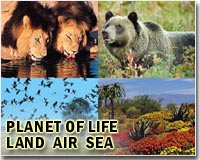| . |  |
. |
Washington DC (SPX) Feb 09, 2010 The loss of wetlands in the prairie pothole region of central North America due to a warmer and drier climate will negatively affect millions of waterfowl that depend on the region for food, shelter and raising young, according to research published this week in the journal BioScience. The new research shows that the region appears to be much more sensitive to climate warming and drying than previously thought. "The impact to the millions of wetlands that attract countless ducks to these breeding grounds in spring makes it difficult to imagine how to maintain today's level of waterfowl populations in altered climate conditions," said Dr. Glenn Guntenspergen, a U.S. Geological Survey researcher and one of the report authors. "Parents may not have time to raise their young to where they can fly because of wetlands drying up too quickly in the warming climate of the future," he added. A new wetland model developed by the authors to understand the impacts of climate change on wetlands in the prairie pothole region projected major reductions in water volume, shortening of the time water remains in wetlands and changes to wetland vegetation dynamics in this 800,000-square kilometer region in the United States (North and South Dakota, Montana, Minnesota and Iowa) and Canada. Many wetland species - such as waterfowl and amphibians - require a minimum time in water to complete their life cycles. For example, most dabbling ducks - such as mallards and teal-- require at least 80 to 110 days of surface water for their young to grow to where they can fly and for breeding adults to complete molting, the time when birds are flightless while growing new feathers. In addition, an abundance of wetlands are needed because breeding waterfowl typically isolate themselves from others of the same species. "Unfortunately, the model simulations show that under forecasted climate-change scenarios for this region (an increase of 4-degrees Celsius), the western prairie potholes will be too dry and the eastern ones will have too few functional wetlands and nesting habitat to support historical levels of waterfowl and other wetland-dependent species," said Dr. W. Carter Johnson, another study author and a researcher at South Dakota State University. The authors noted that their model allowed a more comprehensive analysis of climate change impacts across the northern prairies because it simultaneously examined the hydrology and vegetation dynamics of the wetland complex, which are both important for the wildlife that depend on the prairie potholes for part or all of their life cycles. "Our results indicate that the prairie wetlands are highly vulnerable to climate warming, and are less resilient than we previously believed," said Guntenspergen. "All but the very wettest of the historic boom years for waterfowl production in the more arid parts of the prairie pothole region may be bust years in a 4-degrees Celsius warmer climate." These findings may serve as a foundation for managers and policy makers to develop management plans to prepare for and adapt to climate change in the prairie pothole region. The article, Prairie wetland complexes as landscape functional units in a changing climate, was published in BioScience (60[2]:128-140) and authored by researchers with South Dakota State University, the U.S. Geological Survey, University of Montana, St. Olaf College, The Desert Research Institute-University of Nevada, and the University of Idaho.
Share This Article With Planet Earth
Related Links USGS Darwin Today At TerraDaily.com
 Fewer than 50 wild tigers left in China: conservation group
Fewer than 50 wild tigers left in China: conservation groupBeijing (AFP) Feb 8, 2010 Fewer than 50 wild tigers remain in China, a conservation group said Monday, voicing hope that the Year of the Tiger would not be the last for the endangered cats. Xie Yan, director of the China programme for the US-based Wildlife Conservation Society (WCS), said that just 20 years ago tigers still roamed across large swathes of China. But based on data from the year 2000, there are onl ... read more |
|
| The content herein, unless otherwise known to be public domain, are Copyright 1995-2010 - SpaceDaily. AFP and UPI Wire Stories are copyright Agence France-Presse and United Press International. ESA Portal Reports are copyright European Space Agency. All NASA sourced material is public domain. Additional copyrights may apply in whole or part to other bona fide parties. Advertising does not imply endorsement,agreement or approval of any opinions, statements or information provided by SpaceDaily on any Web page published or hosted by SpaceDaily. Privacy Statement |